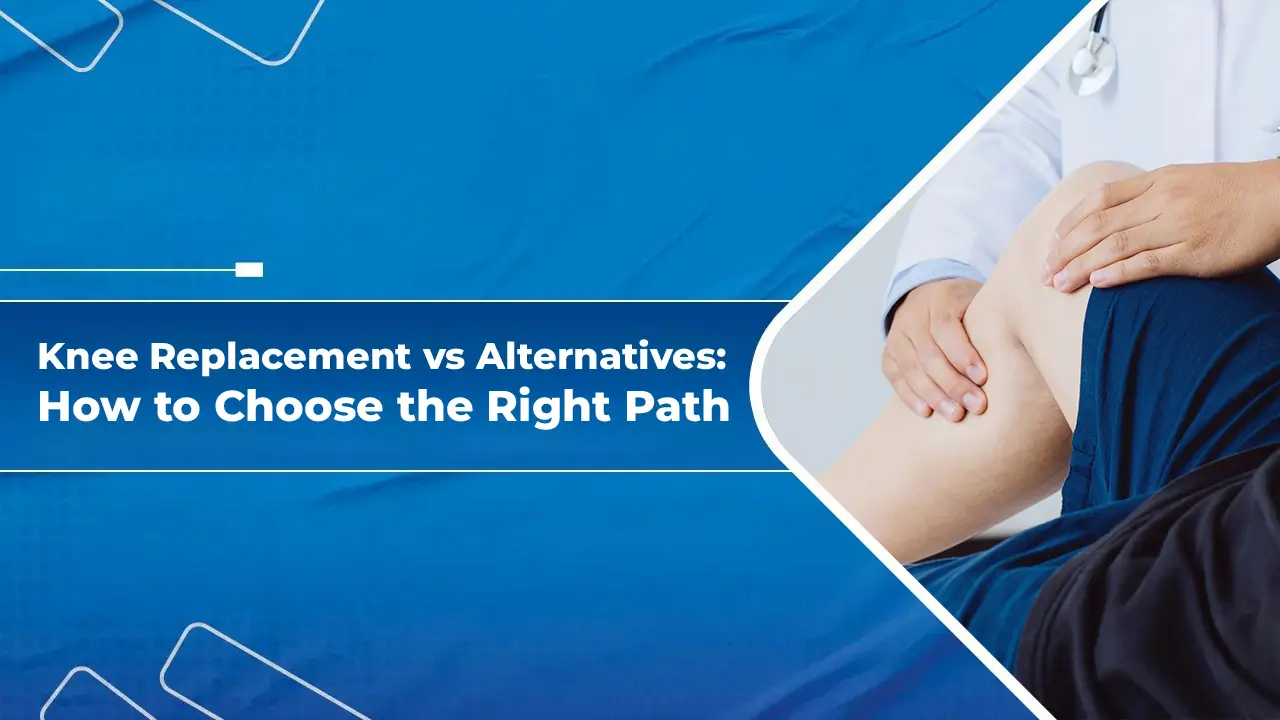
When knee pain starts obstructing daily life, many people tend to assume that knee replacement surgery is the only way out. While knee surgery has become a popular option to get rid of knee pain and regain mobility, it may not be the first or the best solution for everyone. The right treatment for a patient often depends on their age, stage of knee degeneration, overall health, lifestyle, and personal preferences. Before making such a prominent decision as surgery, you must first explore the alternative treatment options.
Understanding Knee Degeneration
The knee joint does not usually degenerate overnight. There is gradual wear and tear over time. In the early stage, you may not even realise that the degeneration process has begun. During stage 2, the damage may be mild, causing occasional stiffness and discomfort. When you reach stage 3, there may be frequent pain, stiffness, and swelling. The word that identifies the last or advanced stage is ‘severe’. Patients may struggle with severe pain and limited mobility. What is important to note is that not every case requires immediate surgery. Many patients in the early stages can manage their symptoms effectively with non-invasive or minimally invasive treatments.
Non-Surgical Management Options
1. Lifestyle Modifications
Simple changes like maintaining a healthy weight, avoiding high-impact and strenuous activities like running and jumping, and taking up low-impact exercises (such as swimming, cycling, stretching, aerobics, or walking) can reduce stress on the knees and ease pain. The importance of weight loss for obese patients cannot be overstated – losing just a pound of body weight can reduce the stress on knees by up to 4 times. It also helps improve range of motion of the knees.
2. Physiotherapy
Physical therapy plays a vital role in managing knee arthritis. Quadriceps strengthening exercises are a key component of physiotherapy for knees. These exercises help improve support and stability. A tailored physiotherapy program that includes strengthening, stretching, and posture improvement techniques, can significantly reduce pain, improve flexibility, and delay the need for surgery.
3. Medications
Over-the-counter pain relievers and anti-inflammatory drugs – NSAIDS (non-steroidal anti-inflammatory drugs) can help manage mild to moderate pain. In some cases, doctors may prescribe stronger medication for short-term relief. However, you should be cautious with long-term use of pain-relief medications because of their potential side-effects on the gastrointestinal system, heart, and kidneys.
4. Corticosteroid Injections
Corticosteroid injections can temporarily reduce inflammation to provide relief for up to 3 months, helping patients stay active without surgery. You may notice pain relief within hours of getting these injections. They are particularly beneficial for patients of knee osteoarthritis. However, you need to be mindful of their repeated use, as it may result in damage to cartilage.
5. Hyaluronic Injections
Hyaluronic acid injections are advised to patients who are not responsive to other treatments. A natural component of joint fluid, hyaluronic acid helps lubricate the knee joint. This helps reduce friction between bones, thereby improving joint function and giving relief from pain. These injections are generally given over several weeks and can give pain relief for up to six months – with minimal side effects.
6. PRP Therapy
Platelet-Rich Plasma therapy is an orthobiologics treatment that uses your own blood to promote repair of tissues. There is a high concentration of growth factors in PRP. It helps stimulate cartilage regeneration while reducing inflammation in the knee joint. Research has revealed the efficacy of PRP therapy in enhancing knee function and alleviating pain in knee arthritis patients.
7. Assistive Devices
Knee braces, knee sleeves, walking aids, or specially designed footwear can give support and stability, and take pressure off the affected knee joint to make movement more comfortable. It helps reduce pain and prevent further damage. You can get custom-fit devices prescribed by your knee doctor.
Minimally Invasive Procedures
If you do not respond well to conservative treatments, your ortho specialist may consider minimally invasive procedures for you:
1. Arthroscopy
A procedure for less severe knee damage, it involves the use of a camera and small surgical tools that are inserted through a small incision to clean up damaged cartilage or repair minor injuries within the joint. Though not a cure for arthritis, it works well for meniscus tears, ligament injuries, and cartilage damage.
2. Osteotomy
This procedure is often recommended for patients with joint misalignment. It involves realigning the bone to shift weight away from the damaged portion of the knee. Bones are cut and reshaped to achieve the goal. It is a preferred choice for younger patients to save the natural knee for a longer duration.
When Surgery Becomes the Right Choice
Knee replacement is generally recommended when:
- You have severe and constant pain, even when you are lying down or sleeping
- Non-surgical methods have failed to provide relief
- Joint damage is extensive, affecting mobility and quality of life
Some patients may still need only a partial knee replacement (PKR) – if the damage is confined to only one portion (or compartment) of the knee. Other patients with more severe damage in the entire knee may require a total knee replacement (TKR).
The Importance of a Second Opinion
Because surgery is such a major decision and a life-changing step, we advise you to get a second opinion. You might think that knee surgery is the only option and may even be recommended the same by your healthcare provider, but another orthopaedic specialist may suggest minimally invasive options you have not known about or explored earlier. Alternatively, the second knee doctor may confirm that replacing the affected knee(s) is truly the best solution.
Final Thoughts
Knee replacement can be life-transforming, but what you need to understand is that it is not the only remedy to knee pain. For many patients, conservative treatments or minimally invasive procedures can push the surgery further for years – till it becomes indeed necessary. Understanding your knee treatment options ensures that you make the best decision for your health, mobility, and long-term well-being.
